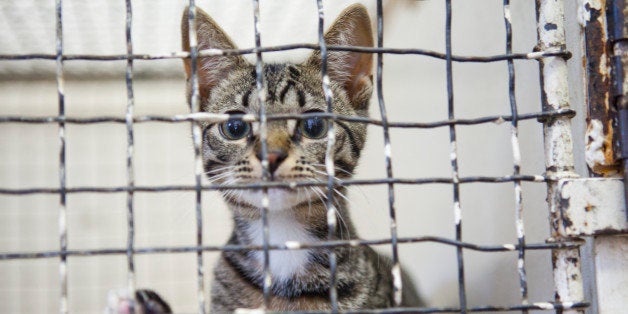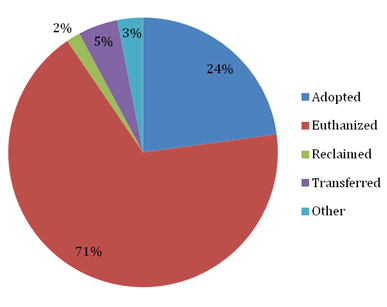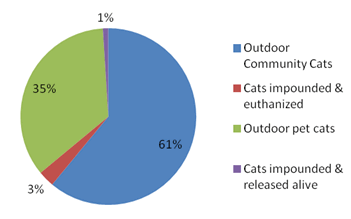
There's a movement starting in animal sheltering that is so logical, so simple, and so right. If you have a few moments for the full presentation, check out this link.
I'll give you the short version.
Outcomes for Cats in California, 2010

Seven out of ten cats that enter California shelters will be euthanized. Is that the role of a shelter? No. In 1998, California enacted the Hayden law, with the intent of ending the euthanasia of adoptable pets. Since then, there have been steps forward and steps back, but overall... no progress on cats. The numbers taken to shelters and euthanized actually rose. Adoptions improved and then stalled. The sad truth is that a stray cat has a better chance of finding a new home -- not to mention staying alive -- if it never sees the inside of an animal shelter.
Now there's change on the horizon. Several shelters have started to balance the intake of healthy cats with their proven ability to find them homes. Rather than accept all healthy cats that come in as strays or are given up by their owners -- often at the price of euthanizing another healthy cat to make room -- shelters give guardians the information they need to re-home a cat themselves, find a way to keep a cat in its home, or place the cat back in its environment (if it's an outdoor animal) after making sure it's sterilized.
The pushback by shelters is long overdue. What other services run chronically over capacity, to the detriment of their clients? Well, maybe prisons, and here in California we can see how well that's working. Even the DMV now schedules appointments. Why not ask pet guardians to wait until the shelter has the space and resources to give an animal the best chance at a good outcome?
A number of misguided beliefs and policies have kept the cat problem from being solved. Some people even think we need to kill cats in shelters to control their population -- that if shelters stopped killing healthy cats, we would be overrun.
That's untrue. California shelters see less than 4 percent of the total cat population. Euthanizing 3 percent of the total population has not and will not control population, even if it weren't unconscionable. Lethal population control has failed with many other species (coyotes, for example) unless the goal is extinction. Moreover, the California state policy set forth in the Hayden bill is for animal shelters is to end the euthanasia of healthy, adoptable pets, not manage populations through lethal measures.
California Cat Population
 A crucial component of the new thinking concerns cats living outdoors--feral or so-called community cats. This chart shows why. The population of outdoor cats, unlike that of cats taken to shelters, is huge. In addition, far fewer of them are sterilized than pet cats. This explains the emphasis on trap, neuter, and release (TNR) to whittle down those populations. And TNR has to be carried out aggressively, purposefully, to reach the point where populations start to drop.
A crucial component of the new thinking concerns cats living outdoors--feral or so-called community cats. This chart shows why. The population of outdoor cats, unlike that of cats taken to shelters, is huge. In addition, far fewer of them are sterilized than pet cats. This explains the emphasis on trap, neuter, and release (TNR) to whittle down those populations. And TNR has to be carried out aggressively, purposefully, to reach the point where populations start to drop.
Feral cats are neither new nor an anomaly. Cats have been hanging around us humans for over 10,000 years, and only in the past seventy years or so have we kept them inside. They have long thrived at arm's length. Cat litter came into use in the 1950s, favoring a life indoors. I don't advocate abandoning cats, but if the choice is between living outdoors or entering a shelter system that will cause them great distress and, in most places, death, then we should consider letting cats exist as they have for millennia.
Some people have concerns about programs that sterilize and release healthy cats back to where they were caught or trapped -- valid concerns about their impact on wildlife and the welfare of the cats themselves. How will they survive? Is it inhumane for the cat?
Feral cats do prey on birds and other small wildlife, to an extent not fully understood. All the more reason, if we're concerned, to reduce their numbers through sterilization (while also confronting worse threats to wild bird populations, such as habitat destruction). Cats can also be returned to places that aren't environmentally sensitive.
As for health, cats living outdoors may be part of a managed colony that offers medical care, including vaccinations, and potential adoption opportunities for kittens. Cats monitored by caregivers may live healthy, long lives.
Compassionate people say they don't want colonies of outdoor cats to be wiped out like rats. Most would rather the cats live out their lives, in homes or not, and would consider the idea of "euthanize them so they never suffer" to be perverse. Even if an agency had the unlimited budget to pursue and kill every feral cat, the effort would fail. The survivors, unsterilized, would just have more kittens. TNR, on the other hand, means that particular cat won't contribute to overpopulation.
Which brings me back to the idea of managing shelter entry, the centerpiece of what Dr. Kate Hurley of the UC-Davis Koret Shelter Medicine Program is calling both a paradigm shift and an "unvicious cycle." People who have chosen to live alongside animals have to stop looking the other way and thinking things can't get better. As Hurley said in the talk I cited above, speaking of ten years of unsuccessful efforts, "What else could we have spent the money on that it took to euthanize over 2.5 million cats? What other needs could that have fulfilled? We know what the feline cost was, but what was the human cost?"
Doing right by cats means shelters reclaim their original role as a place of refuge, protecting human safety and animal welfare, while fulfilling the wishes of a public unwilling to see even caged chickens suffer. The simple expression of those ideals: make the number of cats taken into shelters equal the number that find new homes.